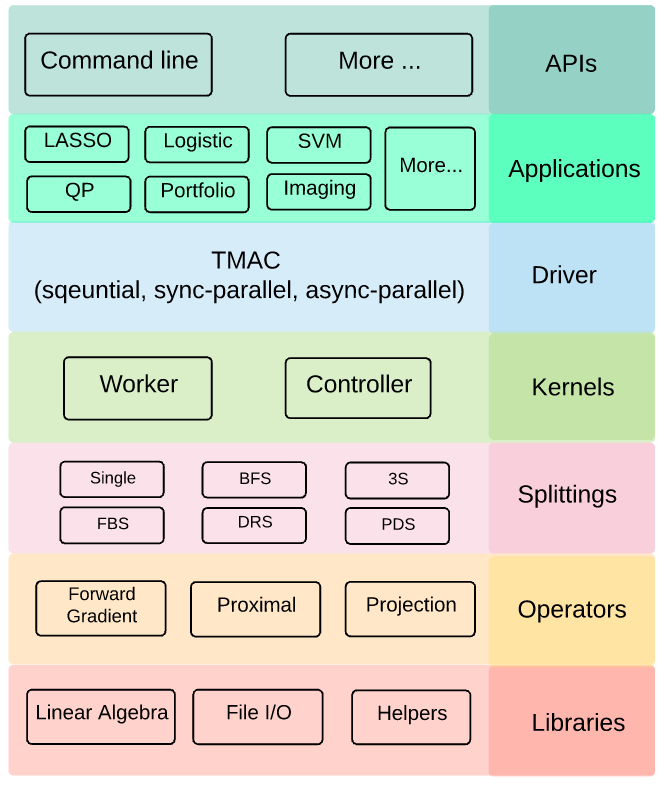Welcome to the TMAC’s documentation!¶
Overview¶
TMAC is a toolbox written in C++11 that implements algorithms based on a set of modern methods for large-scale optimization. It covers a variety of optimization problems, which can be both smooth and nonsmooth, convex and nonconvex, as well as constrained and unconstrained.
The algorithms implemented in TMAC, such as the coordinate update method and operator splitting method, are scalable as they decompose a problem into simple subproblems. These algorithms can run in a multi-threaded fashion, either synchronously or asynchronously, to take advantages of all the cores available.
TMAC is separated into several layers, and this architecture mimics how a scientist writes down an optimization algorithm. Therefore, it is easy for one to obtain a new algorithm by making simple modifications such as adding a new operator and adding a new splitting, while maintaining the multicore parallelism and other features.
The main components of TMAC include:
- A rich set of operators: proximal operators, projection operators, and gradient operators
- Operator splitting schemes: forward-backward, backward-forward, Douglas-Rachford, Peaceman-Rachford
- A shared-memory (asynchronous) parallel driver
- Examples: (sparse) logistic regression, LASSO, portfolio optimization, nonnegative matrix factorization, insection of two sets
- Supported dataset formats: matrix market, LIBSVM
TMAC is written in C++. Python, Julia and Matlab interfaces are under development. The following graph is an overview of the design.

License and copyright¶
Except for the Eigen library header files, all files distributed with TMAC are made available under the New BSD license, which states:
TMAC is a toolbox of modern async-parallel, coordinate, splitting, and stochastic methods.
Copyright (C) 2016 UCLAOPT Research Group
Redistribution and use in source and binary forms, with or without
modification, are permitted provided that the following conditions are met:
- Redistributions of source code must retain the above copyright notice,
this list of conditions and the following disclaimer.
- Redistributions in binary form must reproduce the above copyright notice,
this list of conditions and the following disclaimer in the documentation
and/or other materials provided with the distribution.
- Neither the name of the owner nor the names of its contributors
may be used to endorse or promote products derived from this software
without specific prior written permission.
THIS SOFTWARE IS PROVIDED BY THE COPYRIGHT HOLDERS AND CONTRIBUTORS "AS IS"
AND ANY EXPRESS OR IMPLIED WARRANTIES, INCLUDING, BUT NOT LIMITED TO, THE
IMPLIED WARRANTIES OF MERCHANTABILITY AND FITNESS FOR A PARTICULAR PURPOSE
ARE DISCLAIMED. IN NO EVENT SHALL THE COPYRIGHT HOLDER OR CONTRIBUTORS BE
LIABLE FOR ANY DIRECT, INDIRECT, INCIDENTAL, SPECIAL, EXEMPLARY, OR
CONSEQUENTIAL DAMAGES (INCLUDING, BUT NOT LIMITED TO, PROCUREMENT OF
SUBSTITUTE GOODS OR SERVICES; LOSS OF USE, DATA, OR PROFITS; OR BUSINESS
INTERRUPTION) HOWEVER CAUSED AND ON ANY THEORY OF LIABILITY, WHETHER IN
CONTRACT, STRICT LIABILITY, OR TORT (INCLUDING NEGLIGENCE OR OTHERWISE)
ARISING IN ANY WAY OUT OF THE USE OF THIS SOFTWARE, EVEN IF ADVISED OF THE
POSSIBILITY OF SUCH DAMAGE.
Note that Eigen is MPL2-licensed.